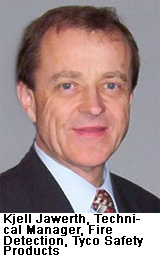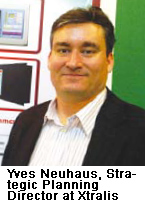Fires are one of the most devastating causes of damage. Whether they are natural or man-made, an outbreak can consume valuable assets and human lives. Commercial buildings need to be adequately armed with fire detection systems to prevent such losses.
Fires are one of the most devastating causes of damage. Whether they are natural or man-made, an outbreak can consume valuable assets and human lives. Commercial buildings need to be adequately armed with fire detection systems to prevent such losses.
Imagine the damage to a shopping mall if a fire broke out. Not only would the merchandise be ruined by smoke and ash, many lives would also be exposed to danger. Recovering from such a liability would be difficult, which is why preventative measures are crucial. Fire detectors are the first countermeasure against fire. Different detectors are used to detect different types of fires before a flame has the time to grow and become unmanageable.
Detectors
Detectors have one goal — to detect a fire. "They are not very different from one another. The main criteria is determined by the area it is meant to protect, which is the width and the length of the room. From there, a detector can be chosen to be fitted," said Ayman El-Hoss, Sales and Marketing Manager of GLT Exports. "Under general government standards, a detector must cover 100 square meters." Thus, the size of the site factors into how many detectors are needed.
Different types of fires require different detectors. "In fire detection, we generally classify a fire as incipient, slow smoldering, smoldering, flaming and clean burning. These, however, are not universally defined," said Kjell Jawerth, Technical Manager, Fire Detection, Tyco Safety Products.
Detectors vary by function. "The detectors are broken down into three different types: optical smoke detectors; optical smoke and heat detectors; and optical smoke, heat and carbon monoxide detectors, which are also called multicriteria detectors," said Leonard Hew, Product Manager, Fire, Asia Pacific Region, Bosch Security Systems. Aspirating smoke detectors (ASD) are used for very early detection, as are flame detectors for detecting clean burning fires.
"In general, heat detectors are used to protect machinery and in places where there is minimal human traffic," Hew said. "Smoke and multicriteria detectors are considered for the protection of human life and critical equipment. They will react to smoke, heat and carbon monoxide density, or change, within an enclosed protected area."
Fire alarms must deliver strong performance. "All detectors are reliable. It is the engineer that has to decide which detector is good for an area. Good engineering judgment can reduce the number of false alarms," El-Hoss said. It is important to assess the environment the detectors are to be placed in by determining the most likely type of fire that may occur, since this decides what type of detector is most suitable. This helps to minimize the occurrences of false alarms.
Aspirating Smoke Detectors
 An ASD system is more expensive, but it is chosen for its ability at early detection. "There are two main criteria you will look at when choosing a fire detection system," said Yves Neuhaus, Strategic Planning Director, Xtralis. "The standard and bare minimum is to look at life safety. This is to make sure people can be evacuated as quickly and safely as possible without loss of life in a fire event. The other is asset protection."
An ASD system is more expensive, but it is chosen for its ability at early detection. "There are two main criteria you will look at when choosing a fire detection system," said Yves Neuhaus, Strategic Planning Director, Xtralis. "The standard and bare minimum is to look at life safety. This is to make sure people can be evacuated as quickly and safely as possible without loss of life in a fire event. The other is asset protection."
"For life safety, there should be enough time to evacuate as soon as a fire breaks out," Neuhaus said. The concept of asset protection applies to critical and/or high-value infrastructure and processes, where business facilities and 24/7 continuity need to be ensured.
ASD is a very early warning system that protects life safety, asset and business continuity, with its ability to detect smoke and fire at its earliest incipient stage. The ASD system by Xtralis provides four alarm levels that can be preset for appropriate staged response. "We rarely reach any fire alarm level, which are the third and forth levels," Neuhaus said. "Normally, we are able to investigate and take response before it escalates to higher alarm levels."
An aspirated smoke detector can cover 2,000 square meters, by drawing air through sampling holes to a central detection chamber with a laser beam, and then using light scattering principle to detect the presence of smoke particles. "Our systems have a wide sensitivity range between 0.005 to 20 percent obscuration per meter," Neuhaus said.
"Our systems also has an auto-learn feature that adapts to the operating environment to optimize performance," Neuhaus said. This way, with the right design and setting, Xtralis' ASD will still work reliably and effectively in a dusty environment.
 Detector Systems
Detector Systems
There are two detection systems on the currently on the market. One is the conventional system, and the other is the addressable system. "Conventional systems rely on zoning," El-Hoss said. "A conventional panel can have one to 100 zones, and each zone is linked to a specific area or floor in a building." This, however, can limit the ability to locate which room the fire is in since it can only give you a general area.
"There can be up to 30 to 40 detectors connected to one zone on a panel. Any one of the detectors among the 30 to 40 activated will trigger the zone into alarm condition, and the alarm zone can be up to 2,000 square meters," Hew said. "Conventional panels come with a fixed number of zones, ranging from two to 120 zones. The more zones required, the bigger the physical panel will be, and the cost will also increase as the housing and modules increases." One must also note that a conventional system may risk losing protection for unconnected areas because there is no way to tell whether there is a faulty detector or broken connections.
Addressable systems are becoming more popular. "Addressable systems are easier to maintain and they tend to be more responsive to fire, and for the operator to locate the fire," El-Hoss said. While conventional systems can take up to 20 detectors in one detection circuit, addressable systems can manage from 126 to 200 detectors, allowing for better accuracy in locating fires.
Also, false alarms are common and can become a nuisance. "Addressable systems are more likely to detect false alarms," said Monica Tsai, Sales Director, Everday Technology.
This is due to the addressable system having more options during setup. "Addressable detectors generally have drift compensation, which compensates for dust buildup and maintains normal sensitivity for a longer time," Jawerth said. "False alarms can be reduced further by using a combination of carbon monoxide and heat detection."
Unlike conventional systems, no areas are at risk of losing their protection due to a single broken connection. "Faulty detectors are flagged on the panel and the exact location is displayed, making troubleshooting less tedious," Hew said. This lets personnel know exactly which detector is going off or is having problems.
 The ability to locate a single device make addressable systems more suitable for larger buildings. "Information is preprogrammed into the system with software labeling of all detectors and control interfaces," Hew said. The devices are also scalable. "There is the possibility to connect multiple panels in a network to monitor a large area. Information can be programmed to be shared among the connected panels, regardless of location, and it can also be shared with an integrated system such as a building integration system (BIS)," Hew said.
The ability to locate a single device make addressable systems more suitable for larger buildings. "Information is preprogrammed into the system with software labeling of all detectors and control interfaces," Hew said. The devices are also scalable. "There is the possibility to connect multiple panels in a network to monitor a large area. Information can be programmed to be shared among the connected panels, regardless of location, and it can also be shared with an integrated system such as a building integration system (BIS)," Hew said.
Price is a determining factor when choosing between a conventional or addressable system. Conventional systems are more affordable upfront. "The addressable system is more expensive, but if you think about cabling and maintenance, it works out to almost the same cost on the long run," El-Hoss said. "We have developed a small addressable panel that is the same size as a conventional panel, since not that many devices are needed in a smaller project. This way, unnecessary wires and devices do not go to waste."
The application determines a project's budget. "Smaller projects generally install a conventional system because there is a budget in place," Tsai said. "Also, they have no need to install that many detectors. Larger projects, such as airports and high-rise buildings, would prefer to have addressable systems. The price may be higher, but it is more suited for their needs."
Each system serves different purposes. "Conventional systems are cheaper to install and have a more mature market, whereas an addressable system is more expensive, is more complicated to install, and requires a control room and personnel to monitor conditions," Tsai said.
Switching or Expanding Systems
There is a broader and cheaper range of detectors for conventional systems, compared to addressable systems. "If you need to add detectors to a conventional system, you may have a greater choice," Jawerth said. "Addressable detectors on the other hand have unique communication data protocols. Some panel manufacturers will support different protocols, but detectors with different protocols cannot be mixed on the same addressable wiring loop."
 Proprietary systems are closed to third-party upgrades. "In turn, this limits the choice the customer has when changing the system or carrying out major overhaul work," Hew said.
Proprietary systems are closed to third-party upgrades. "In turn, this limits the choice the customer has when changing the system or carrying out major overhaul work," Hew said.
This does not mean addressable systems are more limiting compared to conventional systems. "Addressable fire panels allow you to have the flexibility to select what is necessary for the current situation, and also for change in the future without having to commit to a huge investment again," Hew said. "The initial investment in choosing a suitable system for the operation will help to save a substantial amount of money in the future."
Addressable panels are easier to relocate if users need to redesign the detector layout. "Addressable means every detector with an addressable intelligent I/O module has an address, so you know where it is, and it can be moved to any place in the building to be relayed to the monitor," said Albert Liou, VFDS Project Manager, GKB Security. "A conventional system, on the other hand, will need to have more wires added."
If a user wants to add a conventional system to an addressable system, they can be integrated to form a hybrid system to maximize existing wiring and devices. "The existing conventional system can be linked to a zone monitoring unit, which is then connected to an addressable panel," El-Hoss said.
Challenges with Integration
Integration is easier said than done. "The connection for all security systems in the integration must be monitored," Hew said. "Wire integrity has to be intact in case of an emergency, so that the signal to be transferred onto the platform is secured. The user cannot respond unless the information is being correctly relayed."
Integrating the fire alarm panel with BIS can decrease the emergency response time. "The BIS is able to integrate and customize several security systems, such as video surveillance, access control, fire alarm system and PA systems, via high-level integration into one platform:," Hew said.
One important aspect to consider when choosing an integrated system is the communication protocol, which can either be open or proprietary. Using an open protocol can save costs initially during design or tender stages. "It can integrate a variety of security systems from different manufacturers, and a selection of cheaper suppliers is possible," Hew said.
But openness comes with some disadvantages. "Customization is more complex, making the integration process and the maintenance more costly," Hew said. "Extra equipment may be needed to complete the integration, and a gateway for communication is needed for information flow to be complete."
A proprietary integrated system comes from one manufacturer, making installation easier. "It is an easy commissioning process, since all necessary integration tools and processes would have been laid out, thus reducing time and cost," Hew said. "Information flow is also guaranteed." A proprietary integrated system, however, limits product selection and the initial cost may be higher.
Future
Currently, the market is moving towards addressable systems. "It is estimated that 70 percent of all detectors sold are addressable, and 30 percent are conventional. But 45 percent of all systems use addressable panels and 55 percent use conventional panels. This confirms that the conventional systems are smaller, with fewer detectors per panel, and it cannot provide the security needs for larger and more complex environments," Jawerth said.
Conventional systems have fewer external add-ons, which can limit the system's integration with other devices. For example, many addressable systems now have cameras that can locate fires once an alarm is sounded. "Sensors have been developed that can recognize flames and use analytics to determine the fire," Liou said. "This is the newest development in fire security, and video image detector definitions have been defined by the NFPA in the U.S. since 2007."
This new development, called video smoke detection, is still in its infancy. "There are still some issues that need to be worked out," Neuhaus said.